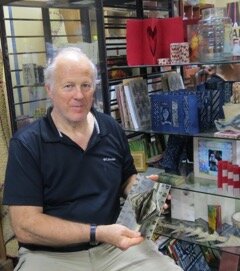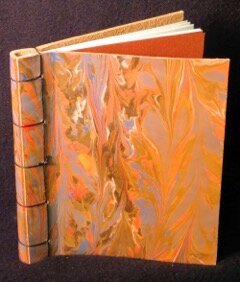Half Measure Studio has been instrumental in opening social interactions that allowed me to individually connect and visit many artists. These informative conversations undoubtedly helped to feature artists in weekly and monthly posts since 2016. In 2020, the year of change and transformation Half Measure Studio will be conducting virtual studio visits, this is our undeniable reality...
During the last three years, I have appreciated the comments and contact from many artists who communicated via email after following my posts. Mark Wangberg, has emailed me enthusiastic responses with continual interest in the art highlighted on my blog. Since he lives and works in Peru, a personal studio visit was impractical, even less now given the transportation and public health circumstances.
© 2020 Louise Levergneux. A small section of The Painted Desert in the Petrified Forest National Park in Arizona.
Mark was kind enough to send images of his atelier and artists’ books for me to report on the history behind his work and lifestyle in Peru.
In 1973-74, in Nigeria, I discovered the lovely goatskins being produced and used for various crafts. At the time I wasn't aware of the tremendous quality and use of this material in fine bindings all over the world. I had been doing letterpress printing for two years at Alma College in Michigan. My comprehension of the incredible beauty and variety of artists' books was merely beginning. I published a number of limited edition books under the Jack-In-The-Box press name.
© 2020 Irma Chavez Cobos. View of Mark’s garden and the river flowing behind his house — a branch of the mighty Amazon River!
Ultimately (1979-80) I apprenticed with Daniel Tucker of Turtle Island Press, and through his excellent tutelage expanded my skills and knowledge for book arts. He indeed supported me in recognizing the possibilities for combining the total aspects of a book, so all components (materials, text, images, color, texture, etc.) were unified.
Many years later, while teaching art (including book arts in my curriculum) at a public high school outside Philadelphia, I achieved a MFA in Book Arts at The University of the Arts in 1999. Working with Hedi Kyle for those five years, blew my mind with NEW possibilities. Her inventiveness rubbed off on me and my students!
© 2020 Mark Wangberg. Mark’ studio with a big vitrine keeping his book samples from the past 40+ years safe!
Hedi continues being a friend and inspiration! Many other instructors at The University of the Arts had profound impacts on my art and teaching — most notably Nathan Knobler, a teacher who easily doubled my knowledge and critical skills.
© 2013 Mark Wangberg. Hedi Kyle, friend and phenomenal mentor! Here in her home/studio modeling Mark’s Hat/Box/Book, an origami box/book structure; imported printed papers, hand-stained tracing papers, and thread for additional pages; 3.25”x3.25”x1”.
At my best, I "play" with the possibilities of text, materials, image, and context. Living in The Amazon has exposed me to a variety of novel materials. For instance, the use of llanchma, a local bark cloth, encouraged my lifelong dream of doing large quilt-like wall pieces. I also folded, sewed, and dyed it to develop textile versions of some of Hedi Kyle's structures. The usage of digital media and inexpensive printing on canvas-like banner material allowed me to create large format patterns using photographs of local women. By repeating the images, I created "tile" designs similar to ones from the early 1900s adorning historic buildings here in Iquitoswooden, Peru...
© 2020 Irma Chavez Cobos. Mark holding his artists’ book entitled Stencil Me.
© 2013 Mark Wangberg. Stencil Me — a triangular book format by Hedi Kyle. Paper and spray paint over stencils; 8”x3”x.5”.
© 2013 Mark Wangberg. The structure for Stencil Me can be followed on page 100, in The Art of the Fold: How to Make Innovative Books and Paper Structures, by Hedi Kyle and Ulla Warchol.
© 2015 Mark Wangberg. Sample Book; local Peruvian bark cloth (llanchama), local handmade papers, local handspun chambira thread from palm fibers, local natural dyes, spray paint, and local natural leaf; 9”x6.5”x1”.
© 2015 Mark Wangberg. Sample Book.
© 2015 Mark Wangberg. Sample Book.
© 2014 Mark Wangberg. Stab binding; leather with hand marbling using acrylics; the hinges are created by carefully cutting half-way through the leather.
© 2014 Mark Wangberg. Matchbox Book Set; three books in one!
© 2014 Mark Wangberg. Matchbox Book Set. Vellum leather box/book cover is a sliding case, transfer image, stained with graphite, found matches, Nigerian basket pieces, metal scraps, metal box, metal can lid, child’s shoe, orange slice, acetate prints, various papers and threads.
© 2014 Mark Wangberg. This Match Book Set was exhibited at the Philadelphia Museum of Art in response to James Castle’s show featuring his drawings and collages which often used match boxes, destroyed in a flood!
© 2015 Mark Wangberg. Rusty; rusted metal ceiling tile pieces, bottle cap, waxed paper with inlaid threads, double stick tape, waxed thread, approx. 4”x24”x1”.
© 2015 Mark Wangberg. Structure for Rusty is based on an invention by Hedi Kyle, I call the “Up/Down Book”, a simple folded accordion with top and bottom folds to contain the pages in. Exhibited in the Hello Hedi book show at 23 Sandy Gallery. I discovered this structure (a delicate little book) in a box of Hedi’s samples and decided to explore its possibilities with some heavier materials.
© 2015 Mark Wangberg. Up/Down Book, my sample with a paper sleeve; printed imported papers, double stick tape, 20 point folding stock to reinforce the covers; 5”x11”x.25”. Created for a workshop taught at the Art Escape art center in California.
© 2013 Mark Wangberg. May I Buy Your Vote; tin can and tin can pieces cut into figures and shapes, thread; poem printed on a sheet of 8.5”x11” brown paper; 8”x3”x3”.
© 2013 Mark Wangberg. Mark came across a pile of old rusted tin cans while in Peru and noticed that they had come from a politician seeking office. After Mark asked local people about these tin cans, he found that politicians were in the habit of painting people’s homes (a relative luxury for many in Iquitos, Peru) in exchange for their vote… Mark started thinking about how often in MANY countries politicians garner votes in various (illegal) ways…
For the foreseeable future, all artists and studio visits will be done virtually. The pleasant side of this situation is to be able to explore ateliers and connect with artists I may never have encountered in my real time travels.






















